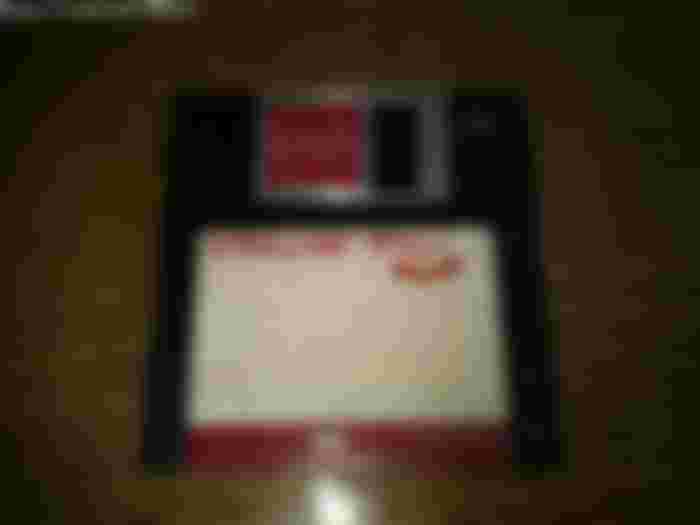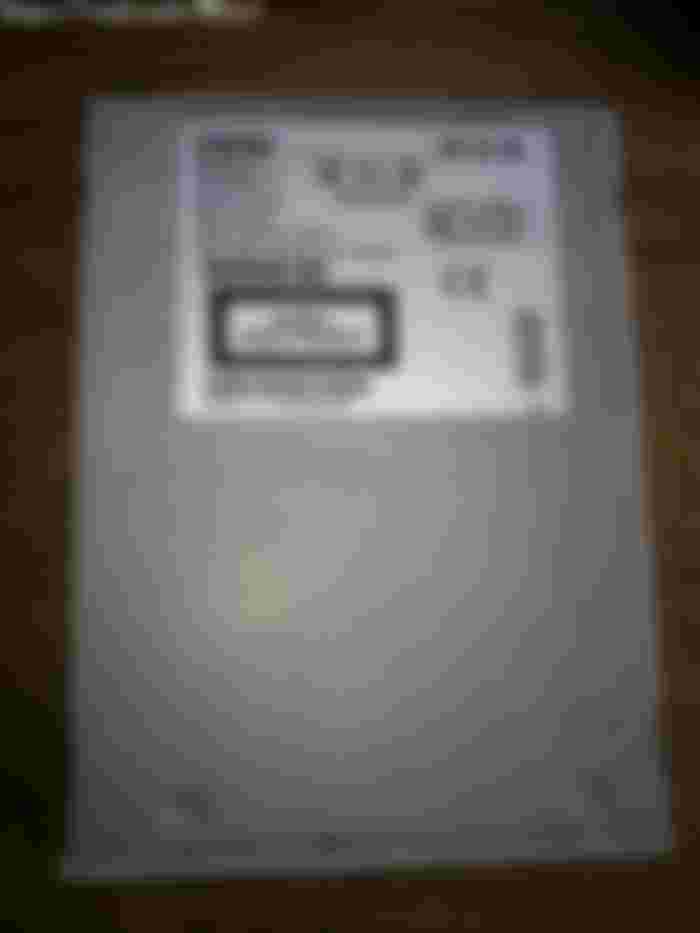In this article, i will explain and showcase how computer data storage was developed. Instead of merely quoting raw data, i will explain the phases of each era, and the reasons, pros, cons for each data storage type. I will also explain, how it was to use the various type of data storage technologies, from a personal point of view. This article will only cover data storage for personal computers, and will not cover specialized, or unpopular methods of data storage. This showcase is organized in order by date of the actual usage of the particular data medium, and not necessarily by the date of invention.

The first computers and game consoles
The first 8 bit personal computers had no data storage, besides their internal ROM or EPROM. The EPROM (read only memory) is a chip, that can be imagined as a non-writeable data storage. Most EPROM chips can be erased and rewritten with special hardware, but the computer itself can't treat is as a disk to store data. This ROM or EPROM chips usually stored the operating system of the computer (which was typically a BAISC interpreter) and people had to type in the BASIC programs to the computer from a paper.

picture: EPROM chips used to store BIOS on a Pentium 1 motherboard
Game consoles and some computers had cartridge slots, where people could connect their own programs and games. These cartridges contained a ROM chip as well, which contained the code. The contents of these cartridges was read-only, and they were relatively expensive. Basically all the software by large companies. The size of the ROM chips in the late 70s and early 80s typically scaled from 4 kbyte to 16 kbyte, which was able to hold the operating system of a computer, or a typical game, or the control software for manufacturing equipment.

picture: ROM based game cartridges for
the Russian Dendy Junior game console (NES clone)
The need for readable and writeable media
Even in this era, it was clear that the ROM based data storage is too rigid for common usage. The need for cheap readable and writable medium formats has been appeared, especially as more and more people bought a computer and game console. Various projects were started by IT corporations to satisfy the need of the masses. Projects involved technologies mostly related to magnetic or laser-based data carrying materials. There were no standardized type of connections or data bus systems to connect new types of data storage devices, so those had to be invented as well.
Compact Cassette
Audio cassettes were already widespread in the early 80s. Computer manufacturers figured out they could use these cassettes to store computer programs. The cassettes were connected to the computer with cassette players and/or recorders. The operating system of the computer interpreted the data stored to the cassette, and after the user pressed the play button, he was able to load the program. Some computer setup also made it possible to store the data in the memory back to a cassette.

Picture: Typical cassette drive for 8 bit computers.
The bits (0 and 1 ) was represented on the cassette by the signal amplitude, signal direction, or signal frequency. In the case of a 60 minute compact cassette, each side of the cassette were able to store up to 100 Kbyte data. If the user recorded multiple programs to the cassette, he had to remember where he recorded the program or the data, to be able to find it easier later on.
source: A Youtube video showcasing cassette based program loading
Some radio stations typically in the soviet bloc, sometimes aired computer programs, which users were able to record to tapes, and later on, use on their computers. The data format of different type of microcomputers were not interchangeable. Which means the tape signal of an Atari microcomputer was not compatible with the tape signal of a soviet Hobbit computer or with any other type of computer. Program compatibility would been out of the question anyway, as all the computers used different processors and operating systems.
The users were also able to copy the contents of the cassette with regular dual deck audio equipment, although it made more sense to load and save the programs with the computer itself to avoid data signal degradation in some cases. Some computers had no dedicated audio drives, and used normal jack or tv-audio connectors. These computers needed higher quality cassette players and cabling in some times, or they used decreased data quantity per sides to preserve compatibility with lower quality audio devices.
5.25 Floppy disk
The first real modern method for data storage was the Floppy Disk, in physical size of 5.25 inch. There was other sizes and types available, but the type that catched all the popularity was the dual sided 360 KByte 5.25 inch floppy. A floppy works by magnetism. The floppy disk has sectors on it, which the magnetic head can read and write as the floppy is rotating.

The floppy drive can seek the head through these sectors quickly. This allows floppies to contain modern file system as we know today: files can be stored on them, and the data can be accessed in any order. The dual sided 360 KByte floppy disks got popular by the end of 80s, when 8 bit and 16 bit computers also started to contain floppy drives. This type of floppies were officially called DD/SD, which means dual side, single density. They contain 180 KByte of data on each side. Some systems can only read single side of floppy disks, in that case the disk can be flipped in the drive to access the data of the another side.
The floppy disk drives of the PC
The standard PC type of personal computers shipped with one or two 360k floppy drives. These floppy drives ate up two 5.25 bays, but later on, thinner floppy drives (eating up only one 5.25 bay) were appeared as well. Older 8 bit computers usually have external 5.25 floppy drives, that can be hooked up with special cable designed for that system. On the PC, all 5.25 floppy drive uses the same internal floppy cable connector, and up to two floppy drive can be connected to one cable.

Reliability of the 5.25 inch 360k floppy disks
The 5.25 inch DD/SD 360k floppy disks are really reliable, unless they suffer a physical damage. Such damage can be scratches on the disk surface, or dirt. Chemical materials can damage the surface of the disk, and magnets near to the floppy can unfortunately destroy the data on the disk. In reality, an 5.25 inch 360k floppy almost never loses data, if it is stored properly. The data usually can survive decades. If the floppy gets weak, a full disk format can blank the disk, which sometimes also can restores the weak sectors on the disk.
The performance of 5.25 inch 360k floppy disks
To find a sector on the disk, a typical 5.25 inch PC drive takes about half seconds maximum, to move the had back and forth. When the data is read in sequential order, these drives can output approximately 10-20 kbyte/sec data, which means that the entire disk can be read or be written typically within 30 seconds in a PC-type computer.
The 5.25 inch floppy disks winning the industry
By the late 80s early 90s, almost every computer got equipped with 5.25 inch floppy drives. The operating systems, such as DOS, were prepared to be able to handle complex directory systems, and a typical FAT file system on a floppy disk can store hundreds of small files, or bigger files in total of 360 KByte. At this era, this was plenty of storage space, typical programs (com type programs) were only 64 kbyte in size, or smaller.
My personal experience with 5.25 inch floppy
My friends at school mostly had C128 computers, which was equipped with an internal 5.25 inch floppy drive. They had hundreds of floppies full with games. There was only one or two broken floppy in the heaps, but otherwise, problems rarely occured. Later on i got a PC clone, which was unfortunately not directly compatible with the C128. Both my PC clone and their C128 required 5.25 inch 360k floppies, however, the C128 used different type of sectors, so the disks were not accessable unless you have formatted them, which meant the data is being lost on them.
Typical usages of PC 5.25 inch floppies
I remember carrying data back and forth to elementary school on 5.25 inch floppies. I have usually simply put the floppy between books, carefully not to bend it, but otherwise i havent used any special means of protection. Sometimes i just brought them in my hand all the way, or carried them on bike holding in my hands. We had a computer club in school and we used the floppies to bring games, programs, data from/to the computer club.
Limitations of the floppy disk
The 5.25 inch disks were limited to 360 KByte of data. A new version, containing 1.2 MByte of data were also released, however this needed new drive. The new 1.2 MByte drive was able to format the 360 KByte floppies to 720 KByte. The new 5.25 inch 1.2 MByte floppies and floppy drives didn't became wide spread, because the technology got new rivals. The 360 kbyte floppies was not conviniend to be used alone in the computer. In PC type of computers, one floppy contained the operating system and maybe one or two programs and drivers, the another one was always the data. It was not convinient to copy data from one drive to another in such type of usage, and programs also started to grow in size.
The arrival of MFM hard disks
The new technology of magnetic data storage was the hard disk. Hard disks differ from floppies not just in size, but in their whole conception. Hard disks were not removable from their hard disk drive, they had their own controller integrated on them. A hard disk drive contains one or two platters, a stepper motor that moves the read and write head, and they was closed in a steel box to protect them from damage. Hard disk drives had their own type of connector standard called MFM. They required their own MFM controller card, which was typically an ISA slot card. The hard disk had to be formatted with the firmware of the MFM card. Once the hard disk were formatted with the given MFM card, the disks were appearing for the system. The cylinder, head, sector number had to be remembered and entered manually if the hard disk and the card were moved to a different system. The MFM card and the hard disk was not interchangible, the card was not replaceable to a different model of a different brand. If your card died, and you have replaced the card, chances are you had to format the hard disk again, losing all of the data on it.
source: video, showing an MFM hard drive in operation
The monstrous sizes of MFM hard drives
A typical MFM hard drive was 10 or 20 MByte in size. Bigger models also existed, but the most widely used were the 20 MByte model. The new MFM hard disks were just as monstrous in data storage sizes: their phisical size was large as well. The first MFM hard disks occuplied two 5.25 ich slots, similarly to the first 5.25 floppy drives. Later MFM hard drives were shrinked from occupying two 5.25 bays to just occupy one single slot. Hard drives from this era had a front plate with air small vents and leds, showing power, activity, and one or more leds for reading and writing the data. Typically, 8088, 8086, 286 and very early 386 computers had this type of hard disks.
The role of hard disk
These MFM hard disks were not meant to be carried around, obviously this were meant as an internal storage only. The 5.25 inch 360k floppy disk drives were kept in these computers, they took the role of carrying the data around. The 20 MByte of the internal hard disks meant enough place to store the operating system (DOS or Windows 3.x), some basic programs, programs for writing programs, text editors, and a few early PC games.
Usability of computers skyrocketing
The apperance of these hard disks opened the new modern era of computing. Finally there was enough space to store the data on the computer, and real software, requiring more than a few 10 kbyte, can be written. This meant that complex office programs, video games became available, and operating systems were able to mature into the modern environments we know nowadays. The early MFM hard disks were able to read and write the data with multiple 100 kbytes per second, large loading times of large programs and documents got shortened basically into seconds.
Floppy technology is advencing
To encounter the limitations of 5.25 inch floppy disks, a new, smaller type of floppy disk type was developed. The new 3.5 inch floppy drives initially supported only 720 kbyte, but they got quickly replaced by the 1.44 MByte 3.5 inch floppy drives and disks. The 1.44 MByte floppy disks don't flop, as they are housed in a rigid plastic case. They have an aluminium cover which protects the disk surface from accidentally touching it. As the new 1.44 MByte disks are smaller, far more robust and housed in a rigid case, people were able to handle them with less care. It can be easily thrown into your pocket, or to your backpack without basically any care. As it can store about 4 times more data as the old 5.25 inch floppy disk, the form factor quickly became popular.

The 3.5 inch floppy disk becomes popular
The 286-era computers in the early 90s usually had an 5.25 and a 3.5 ich floppy drive as well. By this time, the 3.5 inch floppy disks outsold the 5.25 disks. 386 based computers from the 90s typically have an internal 40-ish MByte hard disk combined with only an 3.5 inch floppy drive, they dont usually have an 5.25 inch floppy drive any more. Of course, if it was needed, the older floppy drive can be added as well. The 3.5 inch disks were available in packages of 10 floppies per box, and even people who had no computers, usually kept a few of them to store their personal data.

Longevity of 3.5 inch floppy disks
Unfortunately, the quality of the 3.5 inch floppy disks are far weaker compared to the 5.25 inch disks. As the surface per data is much smaller, the disk surface is more prone for data failures. The 3.5 inch floppy was a typical mass product, with cheaper manufacturing, and the quality of 3.5 drives weren't fantastic either. There was better brands, such as 3M, and bad ones, such as TDK. My experience with TDK disks are about 90% failure rate within 5 years, meanwhile in comparison the two 3M branded 3.5 inch floppy disk i have, still going healthy after nearly 3 decades.
3.5 inch floppies and a terrifying experience
3.5 inch floppy disks was not reliable, especially the cheaper brands. At least one or two file almost always ended up unreadable after carrying the data home. Sometimes even formatting them was impossible, as the drive signaled track 0 bad error, and people was not aware that they needed specialized program to recover the floppies, so they threw it away instead. People mishandled these floppies, throwing them around, putting them to dirt, which just made the things even worse. Despite of this huge unrealibility, the form factor became a standard, and basically every computer had a 3.5 inch floppy drive from approx 1994, up to almost 2010. Video games were shipped on 3.5 inch floppies only for a few years, but hardware drivers were primarily arrived on floppies even in the early 2000s. Governments, police departments, and other type of offices used floppies primarily to exchange and deliver data from A to B even in the late 2000s. The last time i delivered data on 3.5 inch floppy disk was in 2006. A few years later, PC manufacturers stopped using floppy drives, and since 2013 most computer motherboard stopped having a floppy cable connector, which means the technology finally died only a decade ago.
IDE hard disks: MFM hard disks getting replaced
Motherboards started to offer onboard IDE connectors mostly since the Socket3 based 486 computers. MFM hard disk needed three cables to operate: an MFM control cable, an MFM data cable, and a molex power connector. The new IDE standard allowed hard disks and other IDE devices to be made only using one IDE slot and one molex power slot. This decreased the number of cables and complexity. As motherboards integrated usually two IDE connectors, allowing four IDE devices to be connected, every hard disk manufacturer switched to IDE, and the MFM hard disks got replaced by IDE hard disk approx by 1995. A typical IDE hard drive for a 486SX was approximately 80 to 100 MByte in size, later 486 computers got equipped with hard disks in the size of 200-300 MBytes. Initial Pentium based computers were usually shipped with 1-2 Gbyte IDE hard disk drives, and Windows 98 also requires about 250 MByte space to be installed.

picture: IDE hard drive, 2 GByte
Other differences of the new IDE hard disks
IDE based hard drives, unlike the MFM based ones, were almost always shipped in 3.5 inch form factor, or even smaller. IDE hard disks usually use coils instead of stepper motors to position the read-write head. The 3.5 inch drives have no face plates, and only some of the earliest model have their very own activity led. Early IDE hard disks are just as noisy as their MFM ancestors, and bad sectors come just as easily. At least these HDD drives are smaller and less heavy, and they are standardized, so they can be moved between computers without a problem. The first IDE hard disks are limited in 4 GByte in size, as 486 and early Pentium motherboards will not able to detect larger drives. In 1999, the typical hard disk size was 1 GByte.

picture: old 2 GByte IDE hard drive with its PCB
Early IDE hard drive relability
Shrinking the size and increasing the capacity brought a lot of issues for the early IDE hard disks. Similarly to the 3.5 inch floppies, the IDE hard disks started to suffer from serious problems after a few years. Not just randomly appearing bad sectors - those also happened with MFM hard disks as well. After the read/write head assembly got miniaturized, the heads became vulnerable to breaking down and/or crashing into the platters. The magnetism of the disk surface were also weak. The drives usually died a sudden death as they were not able to initialize properly after booting up.
First IDE hard drives and personal experiences
Personally i had the worst experience with Western Digital Caviar drives, especially the drives above 800 MByte to 1.6 GByte. Those drives seemingly never survived more than a few weeks of operation for some reason, and even brand new Caviar drives died after one year for me. Early Western Digital drives offered an approx 100% failure rate. Conner Peripherias and Seagate drives gave me much better results, althrough the early 80 MByte Seagate drives died easily if you kept them in a shelf for more than a year, the bigger ones had this issue fixed. I had good luck with Quantum hard disks, i still have a few 2, 4 and 6 GByte Quantum disks which work well. Maxtor disks had very bad failure rate, from the approx 10 drives i had, only one survived till this day (with a lot of bad sectors). If someone has a retro computer that doesn't supports bigger than 2 or 4 GByte hard disks, i can recommend to use Quantum, Conner or Seagate drives. Despite of their unreliability sometimes, the capacity and simplicity offered by these hard disks made them a must have.
CD-ROM and CD-R
The first hard disks were only 10-20 MByte in size, and the floppies were 360 KByte. This meant a hard drive was able to store the contents of about 50 to 100 floppies. However, as the technology got more advenced, hard disks reached 1-2 GByte in size by the end of the 90s, floppies were only at 1.44 MByte. This meant that more than about 1000 floppies were required the copy the contents of a hard drive. A new soltuion was required. And the solution came in the form of CD-ROM discs. Instead of magnetic energy, the CD-ROM uses lasers and crystals. The first CD-ROM discs for computers came around 1993, but CD-ROM drives only became popular around 1998 for normal users.

picture: a writeable CD-R disc, a rewriteable CD-RW, and an original Microsoft Windows 3.1 installer CD from 1994
The first CD-ROM drives
The first CD-ROM drives were used special connectors and had their own ISA controller cards. Some 386 computers already had such a CD-ROM with controller card. Some CD-ROM drives had to be hooked up to the data interface of the sound card. Since the hard disks switched to IDE, the CD-ROM manufacturers followed them, and they also replaced the old propriretrary interfaces to IDE. Early CD-ROM drives, such as 1x-2x Sony drives were not able to read burned (CD-R) discs, and they were only able to read original CD-ROM discs. They have fixed this limitation in later models. These old CD-ROM drives can read at 1x-2x speeds, which means an approximate 200-300 kbyte/sec speed. Original CD contains up to 650 MByte of data, which equals to a typical cheap low-end hard disk of 1997. Later on, they have released CD with 700 and 800 MByte size as well.

picture: a 24x Creative CD drive from 1997
The CD experience
CD drives can be used under DOS with special device drivers. CD discs are more reliable than floppy discs, and can store the data safely for about one decade, before they start to degrade and rot away. Unfortunately, the price of the CD were very high (about $5 in 1998) plus you had to pay an additional few bucks for the guy who burned the data for you, as CD burners were cost half a kidney back then, so you didn't had any. In the early 2000s, CD discs slowly replaced floppies for the average users.
The early CD burners
Till the end of the 90s, the price of a 1x/2x CD burner was about 300-400$, which was not unpayable, but certainly not a mass product. In the early 2000s the price of such a CD burner - used, second hand - fell to a couple of dollars. The price of a blank CD disc also started to decrease from $5 to around $3 which made the CD the primary format for data storage. From the 2000s the CD slowly took over the role of the floppy disc, as a new and reliable format to store and carry data.

picture: an 8x CD burner from 2000

picture: the same CD burner: notice the vent holes
These early CD burners were only usable for burning CD-R discs, they are very bad at reading. The system and the drive itself could crash if an incompatible multisession CD is being inserted. A non-supported CD-RW can be taken out only after a reboot.
MMC card
As mobile phones became more and more advenced in the early 2000s, they got new super features, such as taking pictures, videos, and being able to record and play back music as well. This wouldn't be possible without a storage. Internal flash storage was not yet advanced enough to be able to carry notable quantities of data. To fix this situation, manufacturers (primarily Nokia) came up with a new type of memory card: the MMC card. The MMC card has no moving parts, it uses specialized cmos logic to store data. It works similarly as other type of data storage mediums, sectors can be read and written and accessed as the applications wish. Nokia and other companies released MMC cards in 16, 32 and 64 MByte size, for their Symbian based cell phones (64 MByte is usually the maximal size supported by early Symbian phones).

picture: an original Nokia MMC card
The usage of MMC cards
A 64 MByte MMC card was able to store 10-15 mp3 files, which turned the phone into an usable music player. An MMC card in such size was also able to record 15 to 30 minutes of 144p video in 3gp format, which made possible to record short video clips or make amatheur movies easily. The apperance of MMC cards opened the pandora's box of cmos based storage devices.
Problems with CD discs
The hard disk technology leaped forward once again. The size of the hard disks increased rapidly. In 1999 a typical computer had a 1 GByte drive, but in 2003, a typical cheap low end hard disk was already 30 GByte. Soon, 80 to 200 GByte hard disks were about to be released for the midrange and high-end. The problem with floppies were about to repeat, and multiple hundreds of CD disks would been required to carry the data between hard disks. There was two way to solve the problem, one of them was mobile rack: mountable rack units to the computer very easily. One part, which the people was able to put their hard disks in, and the another part were mounted to the computer. The another way to solve this problem, was the new DVD format, which i have already written earlier on.

picture: vintage DVD burner
To quickly recap that article in a few words: DVD became mainstream around 2004 when the second generation of DVD burners became available cheaply. DVD discs offer 4.4 GByte of data, which is about 5 times bigger than a CD, but they was not able to ultimately solve the problem in the long term. At least DVD discs are more durable than CD disks, they have a thicker protective layer on both sides of the disc, and they can reliably store the data for multiple decades (if the material is good quality, and the burner is a CLV burner).

picture: rewriteable vintage DVD+RW and DVD-RW discs
The SD cards arrive
Based on the MMC standard, the new SD cards arrived to replace the MMC cards. The SD cards use the same form factor and pin-out, and to some extent, they are backwards and forwards compatible with their ancestor standard. After the initial release, micro-SD cards were also released, which is basically identical to SD cards, but in smaller form factor (there are SD card mount converters allowing to put the micro SD cards into normal SD card slots). A typical early SD card was sized 1 GByte, later on, 2, and 4 GByte models were also released. Nowadays, 32 and 64 GByte SD cards are the most typical size. The 4 and 8 GByte cards - especially from Kingston - were quite unreliable, but otherwise SD cards are pretty reliable and secure way to store and carry your data.

Pendrives
In parallel with SD cards, pendrives (usb mass storage devices) also appeared on the market. Probably i don't have to introduce this to anyone, these are cmos based data storages integrated to usb controller chips. The original pendrives were about 24 MByte in size, and the 1-4 GByte mark were quickly reached before 2010. Nowadays, a typical USB pendrive - similarly to a micro-SD card - is 32 or 64 GByte in size, but 128 GByte models are available as well.

SSD
The size increase of hard disks stopped after 2010. A typical hard drive was 512 GByte to 1 TByte even in 2010, and a typical PC even nowadays barely have bigger than 1 TByte hard disk. A new cmos based technology, following a similar technology as SSD and pendrives, appeared on the scene. The SSD looks similarly to a hard disk, but instead of spinning platters, it have flash memory chips inside. This offers bigger read and write speed than a rotating disk based drive, especially under non-sequencial disk access.
The first apperance of SSD disks
The original SSD disks were used in cheap notebooks and netbooks, they came in a few GBytes in size, 16-32 GByte models were enough for the early Intel Atom based cheap computers around 2010. The conception of SSD drives quickly changed, when they have realized the potential of this technology compared to standard hard disks. Unlike the stagnation of the hard disks, the size of the SSD disks slowly increased. In 2012 a 120 GByte SSD was $100, and right now in 2021 that $100 would buy you an 1 TByte SSD. Hard disks are still cheaper by a few percent, however the HDD manufacturers are switched to panic mode in the past few years. They have introduced a new technology, called SMR (shingled magnetic recording). This technology allows more data to be fitted on a hard disk by partially rewriting the previously stored data tracks on the disks, similarly to roof shingles. This allows cheap 6, 8, 12 TByte hard disks to be manufactured. SSD drives however slowly catching up once again, and by 2024 the SSD drives can reach the TB per price range of hard disks, unless HDD manufacturers make the SMR technology to be even more effective.

picture: a modern half TByte hard disk used in laptops around 2015-2018
The future
As we can see, a typical computer in 1990 had 20 MByte hard disk and 360 kbyte floppy drive.
In 2000, we had 1 GByte hard drives and 650 MByte CD disks to carry the data.
In 2010 we typically had 1 TByte hard drive and 4 GByte rewriteable DVD+/-RW discs to carry our data.
But in 2021, we still only typically have 1 TByte hard drive or SSD in our computer, and we have 32 or 64 GByte pendrives to move the data. The hard disk sizes didn't seem to increase, and we can't expect radical development of flash storage media in the near future as well. By the end of the decade, however, we can expect a typical mid-range computer to have a 12-20 TByte hard drive, and 256 GByte pendrives can be expected to be the standard.




















I am hear because of @Mictorrani suggestions Nice article, this does take be back to the old days. It is great to see data cassette being mentioned, although I never used one as they were before my time, but I use to keep a lot of floppy disks withh all kinds of data. Thanks for this article.